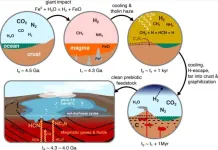(Press-News.org) Scientists in Cambridge University suggest molecules, vital to the development of life, could have formed from a process known as graphitisation. Once verified in the laboratory, it could allow us to try and recreate plausible conditions for life's emergence.
How did the chemicals required for life get there?
It has long been debated how the seemingly fortuitous conditions for life arose in nature, with many hypothesises reaching dead ends. However, researchers at the University of Cambridge have now modelled how these conditions could occur, producing the necessary ingredients for life in substantial quantities.
Life is governed by molecules called proteins, phospholipids and nucleotides. Past research suggests that useful molecules containing nitrogen like nitriles - cyanoacetylene(HC3N) and hydrogen cyanide(HCN) – and isonitriles - isocyanide(HNC) and methyl isocyanide(CH3NC) – could be used to make these building blocks of life. As of yet though, there has been no clear way to make all of these in the same environment in substantial amounts.
In a recent study published in Life, the group have now found that through a process known as graphitisation, significant quantities of these useful molecules can be theoretically made. If the model can be verified experimentally, this suggests that the process was a likely step for early Earth on its journey towards life.
Why is this process more likely to have occurred than others?
Much of the problem with previous models, is that a range of other products are created along with the nitriles. This makes a messy system which hinders the formation of life.
‘A big part of life is simplicity,’ said Dr Paul Rimmer, Assistant Professor of Experimental Astrophysics at the Cavendish Laboratory, and co-author of the study. ‘It’s order. It’s coming up with a way to get rid of some of the complexity by controlling what chemistry can happen.’
We don’t expect life to be produced in a messy environment. So, what is fascinating is how graphitisation itself cleans the environment, since the process exclusively creates these nitriles and isonitriles, with mostly inert side-products.
‘At first, we thought this would spoil everything, but actually, it makes everything so much better. It cleans the chemistry,’ said Rimmer.
This means graphitisation could provide the simplicity scientists are looking for, and the clean environment required for life.
How does the process work?
The Hadean eon was the earliest period in Earth’s history, when the Earth was very different to our modern Earth. Impacts with debris, sometimes the size of planets, were not unheard of. The study theorises that when the early Earth was hit with an object roughly the size of the moon, around 4.3 billion years ago, the iron that it contained reacted with water on Earth.
‘Something the size of the moon hit early Earth, and it would have deposited a large amount of iron and other metals’ said co-author Dr Oliver Shorttle, Professor of natural philosophy at the Institute of Astronomy and Department of Earth Sciences in Cambridge.
The products of the iron-water reaction condense into a tar on the surface of the Earth. The tar then reacts with magma at over 1500°C and the carbon in the tar becomes graphite- a highly stable form of carbon- and what we use in modern pencil leads!
‘Once the iron reacts with the water, a mist forms that would have condensed and mixed with the Earth’s crust. Upon heating, what’s left is, lo and behold, the useful nitrogen containing compounds,’ said Shorttle.
What evidence exists to support this idea?
The evidence to support this theory partly comes from the presence of komatiitic rocks. Komatiite is a type of volcanic rock which are formed when very hot magma(>1500°C) cools.
‘Komatiite was originally found in South Africa. The rocks date back to around 3.5 billion years ago,’ said Shorttle. ‘Crucially, we know that these rocks only form at scorching temperatures, around 1700°C! That means the magma would already have been hot enough to heat the tar and create our useful nitriles.’
With the link confirmed, the authors suggest that nitrogen containing compounds would be made via this method- since we see komatiite, we know the temperature of magma on early Earth sometimes must have been in excess of 1500°C.
What next?
Now experiments must try to recreate these conditions in the lab, and study whether the water, which is inevitably in the system, eats up the nitrogen compounds, breaking them apart.
‘Though we don’t know for sure that these molecules started out life on Earth, we do know that life’s building blocks must be made from molecules that survived in water,’ said Rimmer. ‘If future experiments show that the nitriles all fall apart, then we’ll have to look for a different way.’
END
Drawing a line back to the origin of life
2024-04-18
ELSE PRESS RELEASES FROM THIS DATE:
Data-driven music: Converting climate measurements into music
2024-04-18
A geo-environmental scientist from Japan has composed a string quartet using sonified climate data. The 6-minute-long composition—entitled “String Quartet No. 1 “Polar Energy Budget”—is based on over 30 years of satellite-collected climate data from the Arctic and Antarctic and aims to garner attention on how climate is driven by the input and output of energy at the poles. The backstory about how the composition was put together publishes April 18 in the journal iScience as part of a collection “Exploring the Art-Science Connection.”
“I strongly hope that this manuscript marks a significant turning point, transitioning ...
Palaeontology: Discovery of new ancient giant snake in India
2024-04-18
A new ancient species of snake dubbed Vasuki Indicus, which lived around 47 million years ago in the state of Gujarat in India, may have been one of the largest snakes to have ever lived, suggests new research published in Scientific Reports. The new species, which reached an estimated length of between 11 and 15 metres, was part of the now extinct madtsoiidae snake family, but represented a distinct lineage that originated in India.
Debajit Datta and Sunil Bajpai describe a new specimen recovered from the Panandhro Lignite Mine, Kutch, Gujarat State, India, which dates ...
Racial discrimination and metabolic syndrome in young Black adults
2024-04-18
About The Study: The findings of this study with 322 participants suggest that racial discrimination predisposes Black young adults to metabolic syndrome via sleep problems and inflammation, which may serve as actionable targets for prevention in minoritized populations that could reduce existing disparities and promote health equity.
Authors: Nia Heard-Garris, M.D., M.B.A., M.Sc., of the Northwestern University Feinberg School of Medicine in Chicago, is the corresponding author.
To access the embargoed study: Visit our For The Media website at this link https://media.jamanetwork.com/
(doi:10.1001/jamanetworkopen.2024.5288)
Editor’s Note: Please ...
Adherence to American Cancer Society nutrition and physical activity guidelines among cancer survivors
2024-04-18
About The Study: In this cross-sectional study using data from the Behavioral Risk Factor Surveillance System for 10,000 cancer survivors, only 4% of cancer survivors adhered to all four American Cancer Society nutrition and physical activity guidelines, with the mean number of guidelines met being 2.0. Improved understanding of guideline adherence and its determinants may guide oncologists and general internists in providing recommendations for their patients who have completed cancer treatments.
Authors: Kathryn Norman, M.D., of the Beth Israel Deaconess Medical Center in Boston, is the corresponding author.
To access the embargoed study: Visit our For The ...
New urine-based test detects high-grade prostate cancer, helping men avoid unnecessary biopsies
2024-04-18
ANN ARBOR, Michigan — Researchers at the University of Michigan Rogel Cancer Center have developed a new urine-based test that addresses a major problem in prostate cancer: how to separate the slow-growing form of the disease unlikely to cause harm from more aggressive cancer that needs immediate treatment.
The test, called MyProstateScore2.0, or MPS2, looks at 18 different genes linked to high-grade prostate cancer. In multiple tests using urine and tissue samples from men with prostate cancer, it successfully identified cancers ...
Researchers reduce bias in pathology AI algorithms using foundation models
2024-04-18
Findings of substantial variability in pathology AI models’ performance based on race, insurance type and age group serve as a “call to action” to researchers and regulators to improve medical equity
Large foundation models that incorporate a richer level of detail may mitigate disparities between different demographic groups and enhance model accuracy.
Advanced artificial intelligence (AI) systems have shown promise in revolutionalizing the field of pathology through transforming the detection, diagnosis, and treatment of disease; however, the underrepresentation of certain patient populations in pathology ...
Properties of new materials for microchips can now be measured well
2024-04-18
Making ever smaller and more powerful chips requires new ultrathin materials: 2D materials that are only 1 atom thick, or even just a couple of atoms. Think about graphene or ultra-thin silicon membrane for instance. Scientists at TU Delft have taken an important step in application of these materials: they can now measure important thermal properties of ultrathin silicon membranes. A major advantage of their method is that no physical contact needs to be made with the membrane, so pristine properties can ...
Maltreated children are three times more likely to develop substance use disorders in adulthood
2024-04-18
A new study published in the scientific journal Addiction has found that people who are maltreated as children may be three times more likely to be admitted to hospital for alcohol and substance use disorders by the age of 40, compared with those who are not maltreated.
The study used data from over 6,000 children born at the Mater Mothers Hospital, Brisbane, Australia between 1981 and 1983. Ten percent of those children (609 children) had at least one child maltreatment notification (reported or substantiated) up to 15 years of age. Compared with the rest of the children, those 609 ...
Two U professors selected as AAAS fellows
2024-04-18
University of Utah Health professors Amy Barrios, PhD, and H. Joseph Yost, PhD, have been elected as Fellows of the American Association for the Advancement of Science (AAAS), a lifetime honor that celebrates their excellence in research and commitment to mentoring the next generation of scientists.
Yost and Barrios join a distinguished cadre of AAAS Fellows at the U, including Nancy Songer, PhD; Thure Cerling, PhD; Vahe Bandarian, PhD; Eric W. Schmidt, PhD; Jennifer S. Shumaker-Parry, PhD; and Mario Capecchi, PhD.
Rachel Hess, MD, associate vice president for research at U of U Health, says, ...
Dana-Farber Chief Scientific Officer, Kevin Haigis, PhD, elected as Fellow of the American Association for the Advancement of Science
2024-04-18
Boston - Kevin Haigis, PhD, Chief Scientific Officer, Dana-Farber Cancer Institute, has been named Fellow of the American Association for the Advancement of Science (AAAS). Election as an AAAS Fellow is a distinguished lifetime honor bestowed upon AAAS members by their peers.
Haigis is recognized within Biological Sciences for his distinguished contributions to understanding the complex diversity of cellular dysregulation by different variants of RAS mutations and their consequences in pathophysiology and ...




